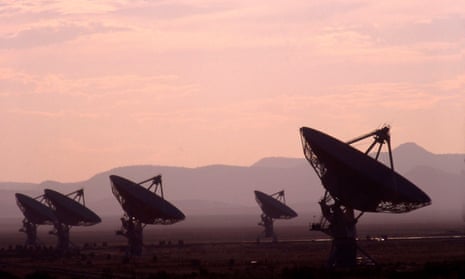I’m an astronomer at the Seti Institute, a non-profit research organization in California’s Silicon Valley. My colleagues and I look for extraterrestrial life, including intelligent beings – or in the vernacular, aliens. It’s exciting times for people like me, because extra-terrestrial life is being widely discussed now in the lead-up to the Pentagon’s highly anticipated report on so-called unexplained aerial phenomena.
Yet I should say straight away that I am not expecting any big revelations out of the report. I think it’s overwhelmingly likely that aliens are present in our galaxy. But I don’t believe they’re hanging out in our airspace. Not now, and not in historic times.
Claims that extraterrestrials helped build large, pointy monuments in the Egyptian desert 5,000 years ago are, frankly, laughable. And I don’t think that videos made by cameras on navy F-18 Hornets actually show alien craft darting around the skies above the Pacific. There are more prosaic explanations for these videos: no extraterrestrials required.
But in a galaxy in which every third star is likely to host an Earth-size planet, it hardly seems possible that our world is the only one sporting intelligence. Which raises the possibility that we might someday make contact. If that occurs, what might the inhabitants of other worlds be like? The question is especially relevant if – as often happens in science-fiction – the aliens decide to pay us a visit.
If extraterrestrials come to Earth, the ensuing scenario would be quite different than picking up an alien radio signal or detecting a flashing laser in the sky, modes of discovery being pursued by my colleagues and myself. The aliens producing such signals will be light years away, and their appearance and intentions wouldn’t be of much concern. But those of anyone landing their spacecraft on our turf would be.
Consider their looks. On Earth, nature has spawned a wide variety of living forms, and presumably would do so anywhere multicellular life exists. All terrestrials have DNA blueprints, and share similarities in molecular makeup. Nonetheless, few of our fellow Terrans resemble us. The extraterrestrials wouldn’t either.
This argues against the iconic aliens of film and TV, those little gray guys who are no more than modified humans. Their four appendages, upright stance, and absence of body hair are simple extrapolations of ourselves. Yes, Hollywood offers up these beings as residents of faraway worlds. But really they’re just the guy next door, lacking in eyebrows and whites in their eyes.
Any aliens that trek to our planet are unlikely to be carbon-based life forms, either hirsute or hairless. Their cognitive abilities will probably not be powered by a spongy mass of cells we’d call a brain. They will probably have gone beyond biological smarts and, indeed, beyond biology itself. They won’t be alive.
The reason is a simple consequence of the staggering distances to the stars. Even the nearest, Proxima Centauri, is 25tn miles from Earth. Our fastest rockets would take 75,000 years to reach it. Neither humans nor Klingons are built to withstand such trips.
You might be thinking that the aliens might have far speedier spacecraft. Without doubt, that’s possible. But there are natural limitations to high-speed rockets. Suppose that an alien would like to cover the distance between Proxima Centauri and Earth in 10 years. Their rocket would need to muster 600m times as much energy as a Saturn V rocket. Double that number if they plan to come to a stop at Earth and engage with the locals.
This may sound like an annoying practical matter that can be dismissed by noting that aliens could be far more advanced than us. And that’s easily possible: The universe is three times the age of our solar system, so the Galaxy may house societies that are millions or even billions of years ahead of Homo sapiens. Nevertheless, while their technology might be in a different league, the aliens must operate under the same laws of physics. Star Trek and similar scenarios aside, it’s extremely difficult to traverse light-years of space in less than a lifetime – anyone’s lifetime. You can call up Scotty in the engine room, but he won’t be able to help.
Traveling from one solar system to another is incredibly difficult and expensive. However, if you’re not in a hurry, the prospects for an interstellar voyage brighten considerably. Such leisurely trips aren’t going to appeal to biological passengers who will die long before their destination is reached. Machines, on the other hand, won’t complain if they’re cooped up in a spaceship for tens of thousands of years. They don’t require food, oxygen, sanitation or entertainment. And they don’t insist on a round-trip ticket.
Artificial intelligence aliens may not be as appealing as those who are warm-blooded and squishy, but we shouldn’t get hung up on an anthropocentric viewpoint. Researchers who work in AI estimate that machines able to beat humans on an IQ test will emerge from the labs by mid-century. If we can do it, some extraterrestrials will have already done it.
Therefore it’s reasonable to expect that any cosmic intelligence paying us a visit will be synthetic. That rules out easy speculation on what the “aliens” will look like. But if it’s a machine, who cares?
Of greater concern would be its intentions. Most sci-fi stories postulate that visitors would be noxious, arriving with a primal urge to obliterate Los Angeles or London. Frankly, if that’s what’s on their mechanical minds, it’s probably impossible to keep them at bay. Chimps couldn’t outsmart humans in any serious confrontation. Likewise, devices who can manage a trip to Earth will have the capability to do whatever they wish once they get here.
It’s a sure bet that any face-to-face encounter with extraterrestrials will be fraught. So, if alien craft ever do settle on the White House lawn, you can hope that whatever’s inside is friendly. If not, there’s always negotiation.
